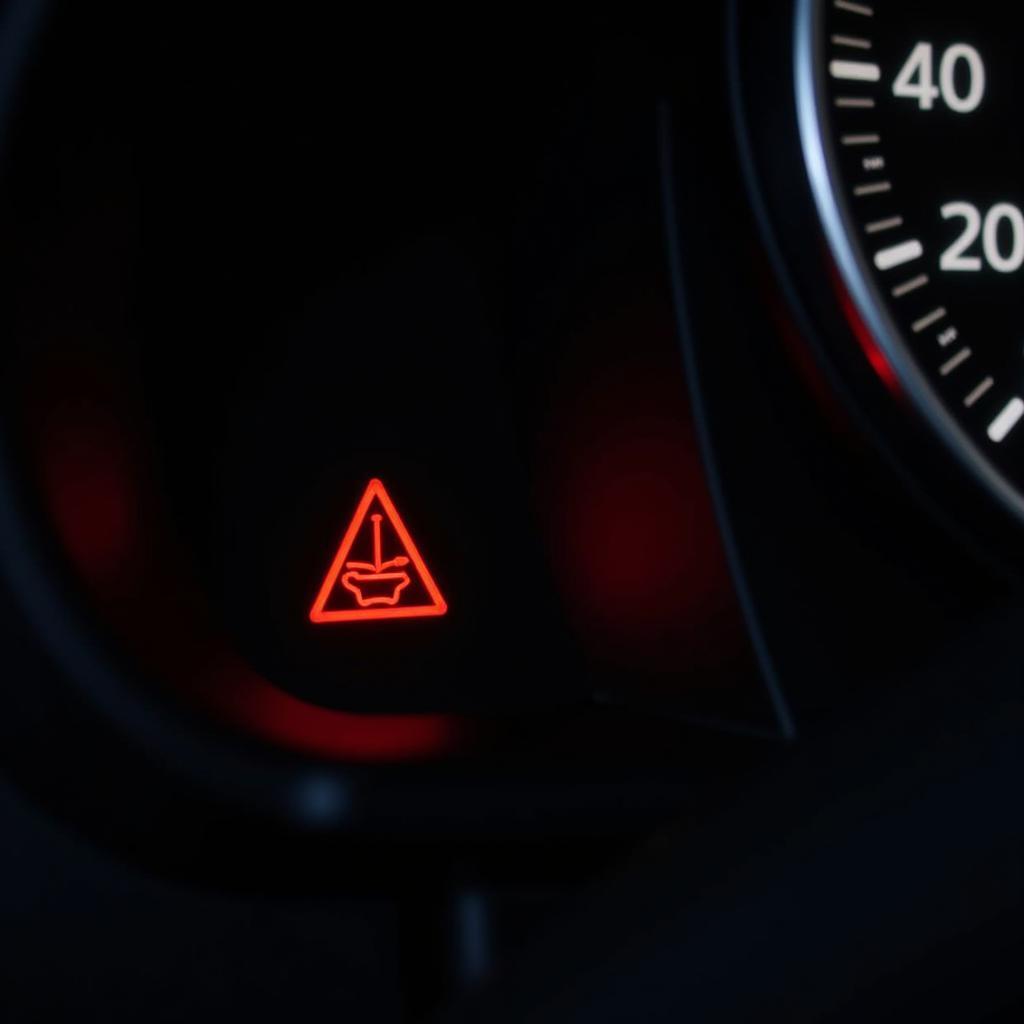The dreaded brake warning symbol illuminating on your Audi’s dashboard can be a cause for concern. This article provides a comprehensive guide to understanding what that “audi brake warning symbol” means, its potential causes, and how you can address the issue, potentially saving you time and money.
Decoding the Audi Brake Warning Light
The brake warning light, often a red exclamation point within a circle or parentheses, isn’t just a single indicator. It can represent various braking system issues, from low brake fluid to more complex problems like ABS malfunctions. Understanding the specific type of warning light and accompanying symptoms is crucial for accurate diagnosis.
Common Causes of the Audi Brake Warning Symbol
Several factors can trigger the brake warning symbol in your Audi. Let’s delve into some of the most common culprits:
- Low Brake Fluid: This is the most frequent cause. Low brake fluid can significantly impair braking performance, making it essential to address immediately. Leaks in the brake lines, worn brake pads, or a failing master cylinder can all contribute to low fluid levels.
- Worn Brake Pads: Brake pads are designed to wear down over time. When they reach a critical thickness, a sensor triggers the warning light. Ignoring this can lead to rotor damage and compromised braking.
- Parking Brake Engaged: While seemingly obvious, it’s easy to overlook. If the parking brake is even slightly engaged, the warning light might illuminate. Double-checking the parking brake lever is a quick and easy first step.
- ABS Issues: The Anti-lock Braking System (ABS) plays a crucial role in preventing wheel lockup during hard braking. A malfunctioning ABS module or sensor can trigger the warning light, potentially impacting your vehicle’s stability in emergency situations.
- Brake System Malfunction: A general brake system malfunction can also trigger the warning light. This could be due to a faulty master cylinder, brake booster, or other components within the system. Professional diagnosis is crucial in this case.
 Audi Brake Warning Light on Dashboard
Audi Brake Warning Light on Dashboard
What to Do When the Brake Warning Light Appears
Seeing that “audi brake warning symbol” can be unsettling, but knowing the right steps to take can empower you. Here’s a guide on how to react:
- Check the Parking Brake: As mentioned earlier, ensure the parking brake is fully disengaged.
- Check Brake Fluid Level: If you’re comfortable, carefully inspect the brake fluid reservoir. If it’s low, adding brake fluid might temporarily resolve the issue, but it’s crucial to identify the underlying cause of the low fluid.
- Inspect Brake Pads: Visually check the brake pads if possible. If they appear excessively worn, it’s time for a replacement.
- Avoid Hard Braking: If the warning light persists, avoid hard braking and drive cautiously. A compromised braking system can significantly increase stopping distances.
- Seek Professional Help: If the issue isn’t easily identifiable or resolved, consult a qualified mechanic or Audi specialist immediately. They possess the expertise and tools to diagnose and repair the problem effectively.
Remote Diagnostic and Programming Solutions
Modern technology allows for remote diagnostics and programming in some cases. This involves using specialized software to access your vehicle’s onboard computer and identify potential issues. While not always a complete solution, remote diagnostics can offer valuable insights and potentially save you a trip to the mechanic, especially for software-related issues.
“Remote diagnostics are revolutionizing car repair,” says John Miller, Lead Automotive Diagnostic Engineer at AutoTech Solutions. “We can often pinpoint the problem and even reprogram certain modules without the car ever entering a workshop.”
Preventing Future Brake Warning Light Issues
Proactive maintenance is key to preventing future brake warning light issues. Regular brake inspections, timely brake pad replacements, and addressing fluid leaks promptly can significantly reduce the risk of encountering this problem.
“Regular brake checks are crucial, not just for your Audi’s performance but for your safety as well,” emphasizes Maria Sanchez, Senior Automotive Technician at EuroCar Specialists. “It’s a small investment that can prevent major headaches down the line.”
Conclusion
The “audi brake warning symbol” is a crucial safety indicator. Understanding its potential causes and taking the appropriate action can help you maintain your vehicle’s braking performance and ensure a safe driving experience. Don’t ignore the warning; address it promptly to avoid potentially serious consequences.
FAQ
- What does the red brake warning light mean? It signifies a potential issue with your braking system, ranging from low brake fluid to more complex malfunctions.
- Can I drive with the brake warning light on? It’s not recommended. A compromised braking system can be dangerous. Seek professional help as soon as possible.
- How much does it cost to fix a brake warning light issue? The cost varies depending on the underlying cause. A simple brake fluid top-up might be inexpensive, while more complex repairs could be significantly more costly.
- How often should I check my brake fluid? It’s a good practice to check your brake fluid level at least once a month.
- What are the symptoms of a failing ABS system? Besides the warning light, you might experience a pulsating brake pedal during braking or difficulty controlling the vehicle in slippery conditions.
- Can worn brake pads cause the brake warning light to come on? Yes, worn brake pads often trigger the warning light due to a built-in wear sensor.
- How can I prevent brake warning light issues in the future? Regular maintenance, including brake inspections and timely part replacements, is crucial for preventing future problems.
